We’ve only got a couple of days left before we move to our new house. In order that she and her little brother might better remember our old house, I encouraged our 6 year-old to record a video tour.
Also available via:
We’ve only got a couple of days left before we move to our new house. In order that she and her little brother might better remember our old house, I encouraged our 6 year-old to record a video tour.
Also available via:
Seven years ago, I wrote a six-part blog series (1, 2, 3, 4, 5, 6) about our Ruth, JTA and I’s experience of buying our first house. Now, though, we’re moving again, and it’s brought up all the same kinds of challenges and stresses as last time, plus a whole lot of bonus ones to boot.

In particular, new challenges this time around have included:

But it’s finally all coming together. We’ve got a house full of boxes, mind, and we can’t find anything, and somehow it still doesn’t feel like we’re prepared for when the removals lorry comes later this week. But we’re getting there. After a half-hour period between handing over the keys to the old place and picking up the keys to the new place (during which I guess we’ll technically be very-briefly homeless) we’ll this weekend be resident in our new home.

Our new house will:
We lose some convenient public transport links, but you can’t have everything. And with me working from home all the time, Ruth – like many software geeks – likely working from home for the foreseeable future (except when she cycles into work), and JTA working from home for now but probably returning to what was always a driving commute “down the line”, those links aren’t as essential to us as they once were.
Sure: we’re going to be paying for it for the rest of our lives. But right now, at least, it feels like what we’re buying is a house we could well live in for the rest of our lives, too.
I certainly hope so. Moving house is hard.
This is a repost promoting content originally published elsewhere. See more things Dan's reposted.
…
I am almost certainly racist.
I don’t intend to be racist, but like I said, intentions aren’t really what matter. Outcomes are.
Note, for example, the cliché of the gormless close-minded goon who begins a sentence with “I’m not racist, but…” before going on to say something clearly racist. It’s as though the racism could be defanged by disavowing bad intent.
…
Yes indeed.
To claim you’re free of prejudice almost certainly means that you’re not looking hard enough. The aim of the exercise is, as always, to keep improving yourself: find where you have (or are) a problem, get better, repeat. We’re not one of us perfect, but we can all strive to be better tomorrow than we are today.
This is a repost promoting content originally published elsewhere. See more things Dan's reposted.
I managed to crack this on my second attempt, but then: I did play an ungodly amount of Kerbal Space Program a few years back. I guess this means I’m now qualified to be an astronaut, right? I’d better update my CV…
This is a repost promoting content originally published elsewhere. See more things Dan's reposted.
My partner @scatmandan just completed his Masters degree. His sister @bornvulcan sent him a stethoscope as a congratulations gift which is one of the funniest things to happen in these parts for a while.
I’m not sure my sister understands that a masters degree is not a doctorate. I don’t feel like I’m qualified to use this.
With #lockdown guidance as it stands, only six of the seven dwarfs can meet together in the park?
The seventh dwarf won’t be Happy.
In fact, he’ll be Grumpy.
Which is a problem, because that means one of the six is Sneezy.
It had been a long while since our last murder mystery party: we’ve only done one or two “kit” ones since we moved in to our current house in 2013, and we’re long-overdue a homegrown one (who can forget the joy of Murder at the Magic College?), but in the meantime – and until I have the time and energy to write another one of my own – we thought we’d host another.
But how? Courtesy of the COVID-19 crisis and its lockdown, none of our friends could come to visit. Technology to the rescue!
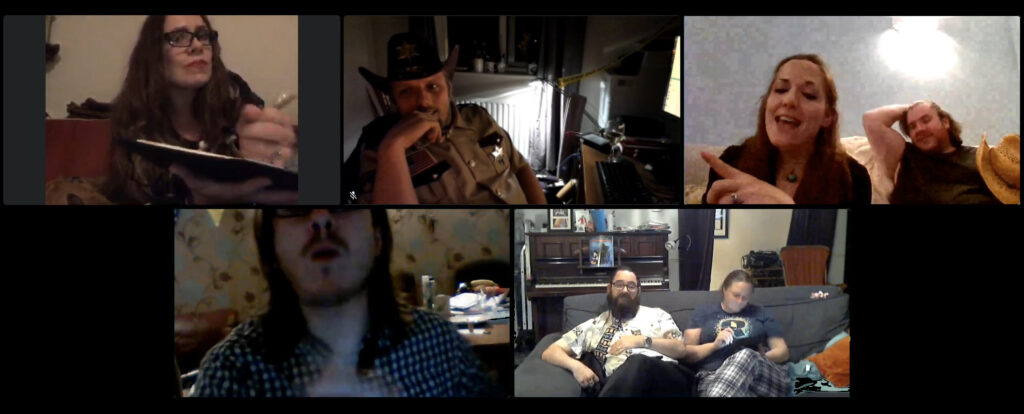
I took a copy of Michael Akers‘ murder mystery party plan, Sour Grapes of Wrath, and used it as the basis for Sour Grapes, a digitally-enhanced (and generally-tweaked) version of the same story, and recruited Ruth, JTA, Jen, Matt R, Alec and Suz to perform the parts. Given that I’d had to adapt the materials to make them suitable for our use I had to assign myself a non-suspect part and so I created police officer (investigating the murder) whose narration provided a framing device for the scenes.
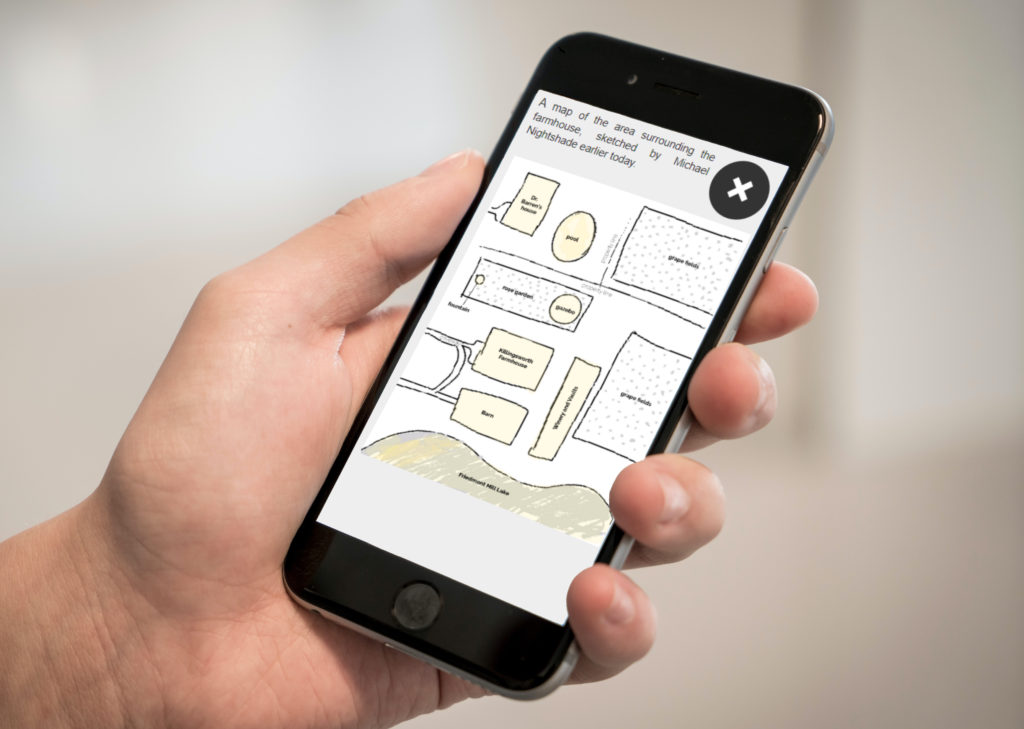
I threw together a quick Firebase backend to allow data to be synchronised across a web application, then wrote a couple of dozen lines of Javascript to tie it together. The idea was that I’d “push” documents to each participants’ phone as they needed them, in a digital analogue of the “open envelope #3” or “turn to the next page in your book” mechanism common in most murder mystery kits. I also reimplemented all of Akers’ artefacts, which were pretty-much text-only, as graphics, and set up a system whereby I could give the “finder” of each clue a copy in-advance and then share it with the rest of the participants when it was appropriate, e.g. when they said, out loud “I’ve found this newspaper clipping that seems to say…”
The party itself took place over Discord video chat, with which I’d recently had a good experience in an experimental/offshoot Abnib group (separate from our normal WhatsApp space) and my semi-associated Dungeons & Dragons group. There were a few technical hiccups, but only what you’d expect.
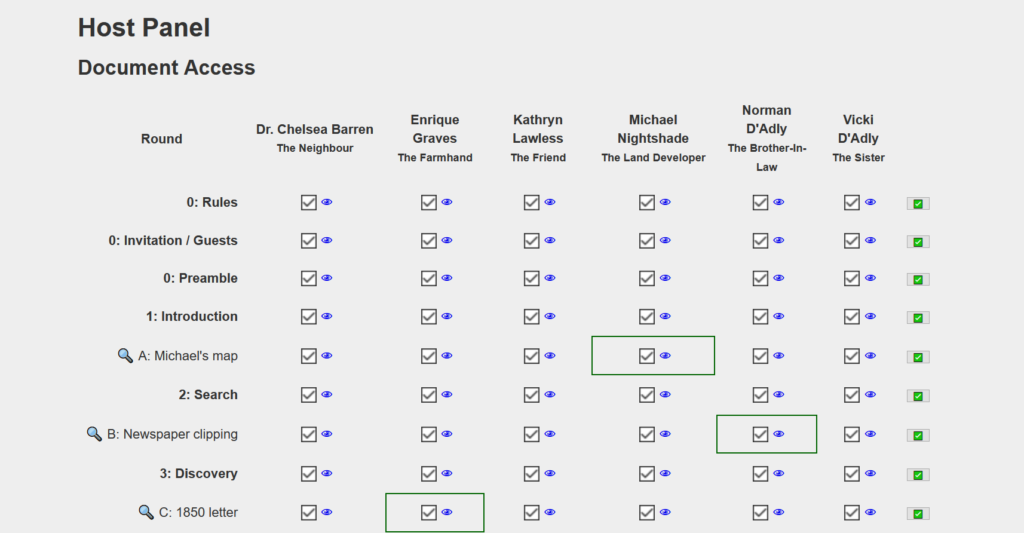
The party itself rapidly descended into the usual level of chaos. Lots of blame thrown, lots of getting completely off-topic and getting distracted solving the wrong puzzles, lots of discussion about the legitimacy of one of several red herrings, and so on. Michael Akers makes several choices in his writing that don’t appear in mine – such as not revealing the identity of the murderer even to the murderer until the final statements – which I’m not a fan of but retained for the sake of honouring the original text, but if I were to run a similar party again I’d adapt this, as I had a few other aspects of the setting and characters. I think it leads to a more fun game if, in the final act, the murderer knows that they committed the crime, that all of the lies they’ve already told are part of their alibi-building, and they’re given carte blanche to lie as much as they like in an effort to “get away with it” from then on.
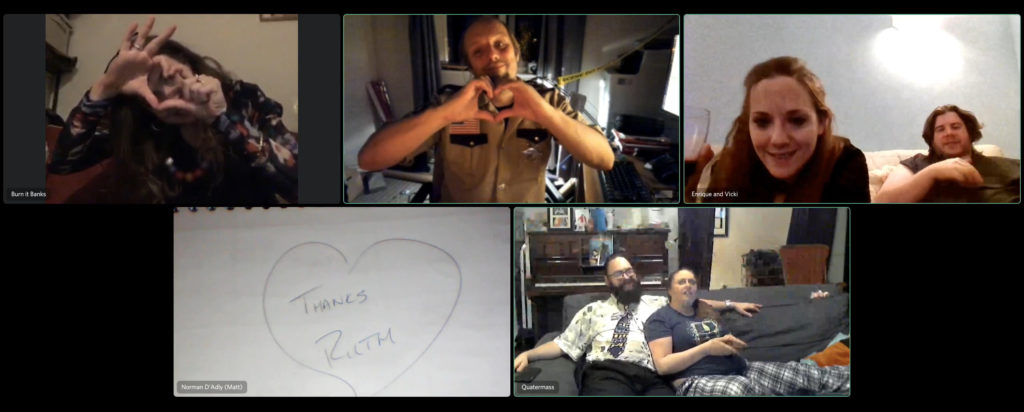
Of course, Ruth felt the need to cater for the event – as she’s always done with spectacular effect at every previous murder mystery she’s hosted or we’ve collectively hosted – despite the distributed partygoers. And so she’d arranged for a “care package” of wine and cheese to be sent to each household. The former was, as always, an excellent source of social lubrication among people expected to start roleplaying a random character on short notice; the latter a delightful source of snacking as we all enjoyed the closest thing we’ll get to a “night out” in many months.
This was highly experimental, and there are lessons-for-myself I’d take away from it:
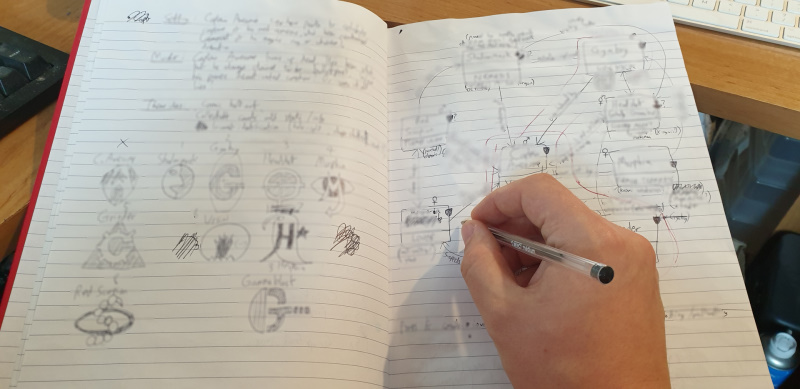
Meanwhile: if you want to see some moments from Sour Grapes, there’s a mini YouTube playlist I might get around to adding to at some point. Here’s a starter if you’re interested in what we got up to (with apologies for the audio echo, which was caused by a problem with the recording software):
This checkin to GC827X6 2019-01-08 51 -1, 09:19 reflects a geocaching.com log entry. See more of Dan's cache logs.
Thanks for the report, Team Hippo. Given the lack of activity and the usual thoroughness of the previous cacher, I’m going to choose to assume that this cache is inaccessible until I can get out there in person to check on it/perform maintenance.
This is a repost promoting content originally published elsewhere. See more things Dan's reposted.
Our sources report that the underlying reason behind the impressive tech demo for Unreal Engine 5 by Epic Games is to ridicule web developers.
According to the Washington Post, the tech demo includes a new dynamic lighting system and a rendering approach with a much higher geometric detail for both shapes and textures. For example, a single statue in the demo can be rendered with 33 million triangles, giving it a truly unprecedented level of detail and visual density.
Turns out that the level of computational optimization and sheer power of this incredible technology is meant to make fun of web developers, who struggle to maintain 15fps while scrolling a single-page application on a $2000 MacBook Pro, while enjoying 800ms delays typing the corresponding code into their Electron-based text editors.
…
Funny but sadly true. However, the Web can be fast. What makes it slow is bloated, kitchen-sink-and-all frontend frameworks, pushing computational effort to the browser with overcomplicated DOM trees and unnecessarily rich CSS rules, developer privilege, and blindness to the lower-powered devices that make up most of the browsing world. Oh, and of course embedding a million third-party scripts to get you all the analytics, advertising, etc. you think you need doesn’t help, either.
The Web will never be as fast as native, for obvious reasons. But it can be fast; blazingly so. It just requires a little thought and consideration. I’ve talked about this recently.
This is a repost promoting content originally published elsewhere. See more things Dan's reposted.
May 27th, 17 years ago, the first release of WordPress was put into the world by Mike Little and myself. It did not have an installer, upgrades, WYSIWYG editor (or hardly any Javascript), comment spam protection, clean permalinks, caching, widgets, themes, plugins, business model, or any funding.
…
Seventeen years ago, WordPress was first released.
Sixteen years, eleven months ago, I relaunched I relaunched my then-dormant blog. I considered WordPress/b2/cafelog, but went with a now-dead engine called Flip instead.
Fifteen years, ten months ago, in response to a technical failure on the server I was using, I lost it all and had to recover my posts from backups. Immediately afterwards, I took the opportunity to redesign my blog and switch to WordPress. On the same day, I attended the graduation ceremony for my first degree (but somehow didn’t think this was worth blogging about).
Fifteen years, nine months ago, Automattic Inc. was founded to provide managed WordPress hosting services. Some time later, I thought to myself: hey, they seem like a cool company, and I like everything Matt’s done so far. I should perhaps work there someday.
Lots of time passed.
Seven months ago, I got around to doing that.
Happy birthday, WordPress!
There comes a point where you’ve run out of new lockdown activity ideas, and you just start combining random pairs of activities you’ve already done. This morning’s first activity was… “Pyjama Party / Water Fight”.
Is it just me, or does “Pyjama Party / Water Fight” sound like a PWL song title?
When the COVID-19 lockdown forced many offices to close and their staff to work remotely, some of us saw what was unfolding as an… opportunity in disguise. Instead of the slow-but-steady decentralisation of work that’s very slowly become possible (technically, administratively, and politically) over the last 50 years, suddenly a torrent of people were discovering that remote working can work.

As much as I hate to be part of the “where’s my flying car?” brigade, I wrote ten years ago about my dissatisfaction that remote working wasn’t yet commonplace, let alone mainstream. I recalled a book I’d read as a child in the 1980s that promised a then-future 2020 of:
Of those three dreams, the third soon seemed like it would become the most-immediate. Revolutionary advances in mobile telephony, miniaturisation of computers, and broadband networking ran way ahead of the developments in AI that might precipitate the first dream… or the sociological shift required for the second. But still… progress was slow.
At eight years old, I genuinely believed that most of my working life would be spent… wherever I happened to be. So far, most of my working life has been spent in an office, despite personally working quite hard for that not to be the case!

I started at Automattic six months ago, an entirely distributed company. And so when friends and colleagues found themselves required to work remotely by the lockdown they came in droves to me for advice about how to do it! I was, of course, happy to help where I could: questions often covered running meetings and projects, maintaining morale, measuring output, and facilitating communication… and usually I think I gave good answers. Sometimes, though, the answer was “If you’re going to make that change, you’re going to need a cultural shift and some infrastructure investment first.” Y’know: “Don’t start from here.” If you received that advice from me: sorry!
(Incidentally, if you have a question I haven’t answered yet, try these clever people first for even better answers!)
More-recently, I was excited to see that many companies have adopted this “new normal” not as a temporary measure, but as a possible shape of things to come. Facebook, Twitter, Shopify, Square, and Spotify have all announced that they’re going to permit or encourage remote work as standard, even after the crisis is over.
Obviously tech companies are leading the way, here: not only are they most-likely to have the infrastructure and culture already in place to support this kind of shift. Also, they’re often competing for the same pool of talent and need to be seen as at-least as progressive as their direct rivals. Matt Mullenweg observes that:
What’s going to be newsworthy by the end of the year is not technology companies saying they’re embracing distributed work, but those that aren’t.
…some employers trapped in the past will force people to go to offices, but the illusion that the office was about work will be shattered forever, and companies that hold on to that legacy will be replaced by companies who embrace the antifragile nature of distributed organizations.
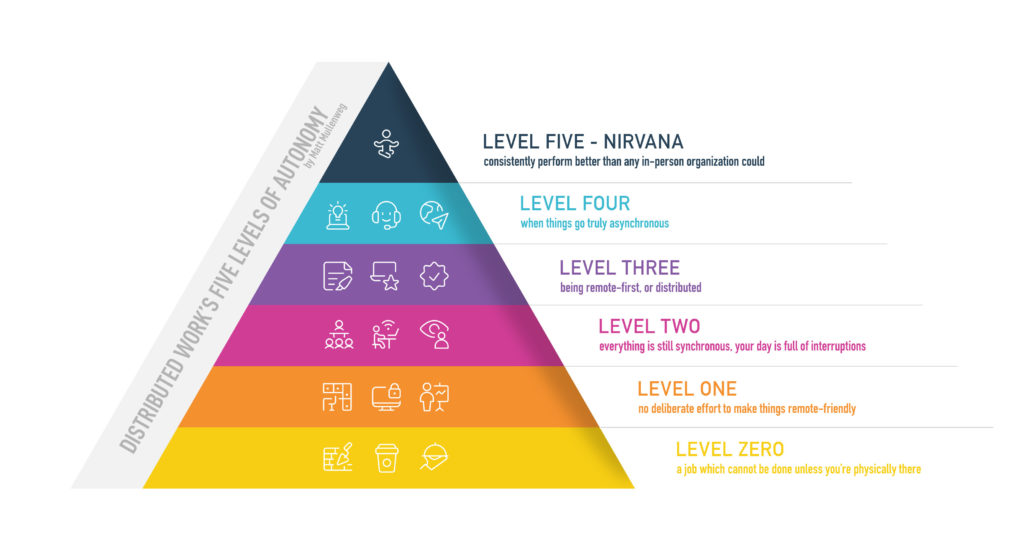
We’re all acutely familiar with the challenges companies are faced with today as they adapt to a remote-first environment. I’m more interested in the challenges that they might face in the future, as they attempt to continue to use a distributed workforce as the pandemic recedes. It’s easy to make the mistake of assuming that what many people are doing today is a rehearsal for the future of work, but the future will look different.
Some people, of course, prefer to spend some or all of their work hours in an office environment. Of the companies that went remote-first during the lockdown and now plan to stay that way indefinitely, some will lose employees who preferred the “old way”. For this and other reasons, some companies will retain their offices and go remote-optional, allowing flexible teleworking, and this has it’s own pitfalls:

These are challenges specifically for companies that go permanently remote-optional following a period of remote-first during the coronavirus crisis.
How you face those challenges will vary for every company and industry, but it seems to me that there are five lessons a company can learn as it adapts to remote-optional work in a post-lockdown world:
I’m less-optimistic than Matt that effective distributed working is the inexorable future of work. But out of the ashes of the coronavirus crisis will come its best chance yet, and I know that there’ll be companies who get left behind in the dust. What are you doing to make sure your company isn’t one of them?
A new Automattician who started this week looked me up to thank me for the first in my series of blog posts (2, 3) about starting with @automattic. I feel useful! 😍
This is a repost promoting content originally published elsewhere. See more things Dan's reposted.
The owner of a pizza restaurant in the US has discovered the DoorDash delivery app has been selling his food cheaper than he does – while still paying him full price for orders.
A pizza for which he charged $24 (£20) was being advertised for $16 on DoorDash – and when he secretly ordered it himself, the app paid his restaurant the full $24 while charging him $16.
He had not asked to be put on the app.
…
This entire news story is comedy gold.
So it looks like food delivery network DoorDash try to demonstrate demand for their services by providing them even if you didn’t ask, then show you how popular they were. So if you run a pizza restaurant, they might start selling your pizzas as “deliveries” to customers, then come and pick them up as “collections” and deliver them. Because they’re trying to drum up support and show how invaluable they would be to you, they might even resell your product at a loss in order to get customers on-board early. It’s all pretty slimy, but I’m sure that wherever they’re operating (New York, in this case) they’ve had the common sense to make all the legal language line up.
(If you can’t see the problem with this model, remember that the customers will be reasonably assuming that the restaurant is involved, so when their pizza turns up cold they’ll phone the restaurant and complain and ask for their money back [or slate them in reviews online]. Plus, let’s not forget that this is a strongarm tactic: once a restaurant has been seen to be offering delivery, customers will be upset if you take the option away… even if you never actually offered it in the first place.)
Anyway: this guy noticed that his restaurant was on DoorDash without his consent, and that they were selling his pizzas for less than he did. So he ordered them from himself: he paid DoorDash $160 for the pizzas, DoorDash paid him $240 for the pizzas, DoorDash sent somebody around to pick them up from him and deliver them to his neighbour. Free money.
Next time he did it, the restaurateur didn’t even bother to put toppings on the pizzas. After all, he didn’t need to be eating them anyway! He was just paying DoorDash to pay him (more) to move them from place to place. The restaurateur and his friend pulled off several off these trades and DoorDash never seemed to catch on. With some investigation, they discovered that it was probably an imperfect scraper that had resulted in the price DoorDash advertised being lower than the price they would pay the pizzeria, which immediately makes me wonder whether you could honeypot it with deliberate scraper-traps… (Owing to various bits of work I’ve done in the past, I’m pretty well-versed in offensive and defensive screen scraper techniques.)
And to finish the news article off, we’re reminded about the attitude of Mosayoshi Son, the CEO of DoorDash’s parent company (which incidentally also tried to buy, and then got sued by, WeWork, demonstrating his financially-savvy). Recently, defending his company’s general trend to attract venture capital and then lose it very quickly, he compared himself first to Jesus, who was also a “high-profile visionary who was initially misunderstood”, and then to the Beatles, who “did not become a success overnight”.
Comedy gold I tell you. And now I want pizza. (Especially if I can persuade a stupid startup to pay me to make and then eat it myself.)
This is a repost promoting content originally published elsewhere. See more things Dan's reposted.
A s*** font that f***ing censors bad language automatically.
This is pretty beautiful, in a sick-and-wrong way. It’s a font which contains ligatures that can be automatically used by supported software. But instead of ligatures for things like æ and œ, this font replaces the letters of common swear words with a glyph that looks like a censor bar. So it’s an automatically-self-censoring font.
Better yet, the authors were aware of the Scunthorpe problem and attempted to mitigate it; this also provides the font’s name. Unfortunately it’s not possible to do so perfectly without adding ligatures for just about every dictionary word individually (now that would be a font) so words like shitake and cockerel still get censored. And even where the mitigation works, it produces other problems: e.g. the use of the ligature Scunthorpe means that the word cannot be broken e.g. hyphenated across two lines. Nor will letter counters work properly.
But I don’t think anybody’s suggesting that this font should actually see mainstream use. Right?